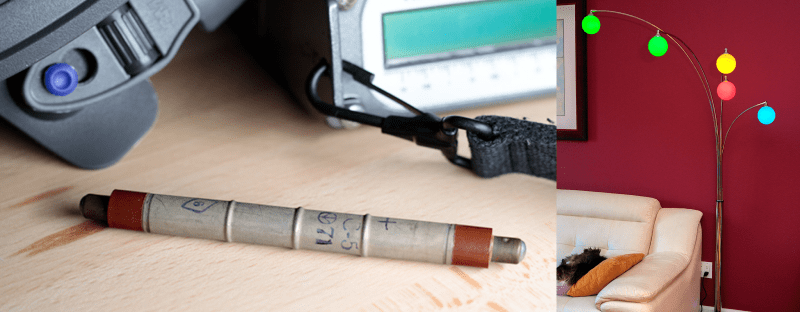[Michal Zalewski] has radiation on the brain. Why else would he gut a perfectly-horrible floor lamp, rebuild the entire thing with high-power RGB LEDs, and then drive it with a microcontroller that is connected up to a Geiger-Müller tube? Oh right, because it also looks very cool, and Geiger tubes are awesome.
If you’ve been putting off your own Geiger tube project, and we know you have, [Michal]’s detailed explanation of the driver circuit and building one from scratch should help get you off the couch. Since a Geiger tube needs 400 volts DC, some precautions are necessary here, and [Michal] builds a relatively safe inverter and also details a relatively safe way to test it.
The result is a nice piece of decor that simultaneously warns you of a nuclear disaster by flashing lights like crazy, or (hopefully) just makes a nice conversation piece. This is one of the cooler Geiger tube hacks we’ve seen since [Robert Hart] connected up eighteen Geiger tubes, and used them to detect the direction of incoming cosmic rays and use that to compose random music (YouTube, embedded below).
[Michal] is also author of the most excellent Guerrilla Guide to CNC Machining and keeps good tabs on his background radiation.















The write up is a classic.
Yep kept me reading.. real gem
I mean … sure. Now I know that I have a huge warhead headed my way, so what next? Am I supposed to make peace with my gods? Wha
“Cool lamp you built. Does it do anything?”
“… Hopefully not.”
Fun build! I haven’t had a chance to play with a Gieger-Müller tube yet, but chances are I’d go the funny/ artistic route also.
The project description is clear and really fun to read! In the event of nuclear catastrophe though, I think the flesh melting off your bones might be a good clue.
Kudos on a clever project and one that’s just plain fun to read about.
To anyone wanting to build HV circuits like this: Please do yourself a favor and buy/salvage some fast diodes with low leakage. 1N400x diodes have higher leakage current and their performance is poor at the frequencies these HV inverters run at.
When I was prototyping a HV supply for a geiger detector, I found that swapping out 1N400x diodes with something faster gave me about 100V more on the output for the same input power.
Yes. Listen up people – 1n400x diodes may not even work at all if using a 50khz CCFL inverter or similar source. They are much too slow in turning off. Addy is right, I use CCFLs all over my lab to run various detectors, from geiger tubes to He3 tubes to photomultipliers – they are nice, efficient, and “stiff” enough that unless the need for precision is extreme, one can simply regulate the input voltage to whatever gets you the output you want (LM 317 or similar).
Fast HV diodes don’t grow on trees, but are well worth finding for this sort of thing.
I live in a stone and brick home. It will flash lights like crazy. although where I moved to has a lot less uranium in the soil so it’s not going to be as crazy.
In ohio the background radiation count is high enough to freak people out.
You might be overestimating the sensitivity to radiation of those Russian new-old-stock tubes. You’ll see some cosmic rays, no alphas, betas but only if the source is really nearby (a few inches, tested with a .5 uC Cs-137 source here), and a fairly narrow slice of the gamma spectrum. Nearly all of the response will be cosmics, even with some pretty hot U ore or Th welding rods a couple inches away. Compared to any real (pancake) or sensitive (scintillator + phototube) detector, these are deafer than a post. More like the old CD ion chamber detectors, these are more like a “how many hours till I die” level of sensitivity. I do fusion research for a living…and own many many detectors of various types. These are mostly good for getting your feet wet at all, nothing you’d use for safety or in a real lab.
If you live downwind of North Korea that lamp would be a particularly good idea at the moment.
So that would be Southern China in Summer and South Korea in Winter.
https://topics.amcham.com.tw/wp-content/uploads/2015/02/East-Asia-seasonal-prevailing-winds-chart-e1423207936968.jpg
These days you don’t just need a Geiger counter but a VX gas detector too though.
I wonder if detectors for that are easy to come by.
VX is a persistent, non-volatile area denial weapon, not gas like and not likely to be used on a large scale.
Contrast that with a failed attempt to launch an armed ICBM by NK and the resulting dirty bomb effect over their own territory, then you do get a wide area of contamination that is spread by the wind. After all who knows how good their fail-safe mechanisms are, or how they would react to being hit with the beam from a 60 kilowatt laser.
A professor in college had a little plastic item like a snow globe, but with no liquid. Instead of snow it had plastic beads that were electrostatically charged and stuck to the globe. The integral instructions said if the balls dropped to seek cover. I guess the ionizing radiation would cause the charge to bleed off or possibly it was a joke item. Never did get to try it.
The circuit in my Geiger uses Zener diodes to set the voltage as close to the plateau voltage as possible. The tubes are relatively sensitive to the voltage, so some kind of voltage stabilizer might be a good idea.
Another option is to use those tiny neon indicators – they need approx 90v (IIRC) and they work as stabilizers when they’re lit. An added bonus – you see that the HV is live!